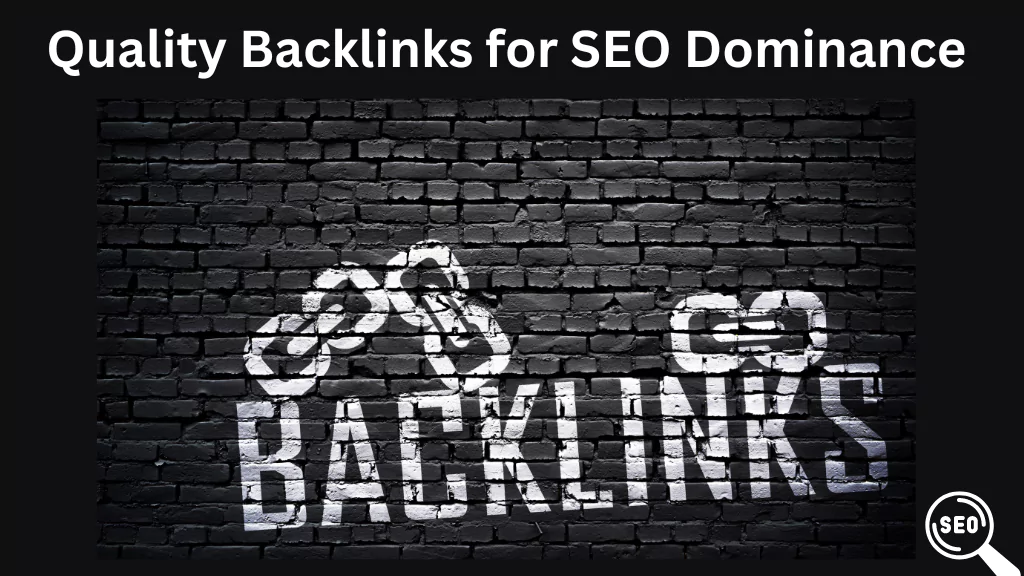Is your website struggling to climb the SEO ladder? Strong backlinks might be the missing link. “The Linksmith’s Guide: Forging Quality Backlinks for SEO Dominance” is your roadmap to building a network of powerful, search-enhancing connections. We promise that by the time you turn the final page of this post, you’ll be equipped with the knowledge to secure high-quality backlinks that can significantly boost your site’s search engine standing. Get ready to forge your path to the top of the SEO hierarchy.

Table of Contents
Toggle
Understanding the Forge – What Are Backlinks?
Imagine a web page as a castle, and backlinks are the bridges connecting it to other, influential fortresses. The more sturdy and well-connected these bridges are, the easier it is for visitors (and search engines) to find your castle. That, in essence, is the power of backlinks. They tell search engines that your content is valuable and deserves to be seen by a wider audience, ultimately boosting your ranking in search results.
But it’s not just about quantity. A single, high-quality backlink from a relevant and authoritative website can be worth more than a hundred low-quality ones. Think of it this way: a link from a renowned university carries more weight than a link from a random blog. So, the focus should be on quality, not just accumulating backlinks like a packrat hoards trinkets.
The Linksmith’s Toolbox – Essential Tools for Backlinking
No self-respecting linksmith ventures into the forge without the right tools. Here are some must-haves in your backlinking arsenal:
- Backlink Analysis Tools: Ahrefs, SEMrush, and Moz are your knightly companions, helping you analyze your own and competitor’s backlink profiles, uncovering opportunities and potential weaknesses.
- Outreach Platforms: Buzzsumo and Pitchbox can be your heralds, streamlining your outreach efforts by identifying relevant websites and bloggers.
- Content Research Tools: Buzzsumo and Similarweb help you discover trending topics and content formats that naturally attract backlinks, making you a magnet for link opportunities.
Sourcing the Metal – How to Identify Backlink Opportunities
Now, let’s delve into the mine where you unearth the precious metals for your backlinks. Here are some rich veins to explore:
- Competitor Backlink Profile Analysis: Study your competitors’ backlinks to see where they’re getting their link love. Analyze the types of websites linking to them and brainstorm similar opportunities for your own site.
- Guest Posting Opportunities: Become a guest writer on relevant websites in your niche. This not only positions you as an expert but also garners you a valuable backlink. But remember, quality matters – focus on authoritative websites with engaged audiences.
- Unlinked Mentions: Sometimes, websites mention your brand or content without linking back. Use tools like Buzzsumo to find these mentions and reach out to the webmaster politely requesting a backlink.
Crafting the Links – Creating Link-Worthy Content
Not just any piece of content will attract backlinks. You need to be a wordsmith, forging link-worthy content that compels others to share and reference it. Here’s your secret recipe:
- Content That Attracts Backlinks: Infographics, research studies, and data-driven pieces tend to naturally attract backlinks. Think of content that is informative, visually appealing, and unique.
- The Power of Original Research and Data: Conduct your own research and present valuable insights that others can’t find elsewhere. This establishes you as a thought leader and a worthy source of information, attracting backlinks like moths to a flame.
- Infographics and Visual Content: People love visuals. Create high-quality infographics and visual content that summarizes complex information in an easily digestible way. These are link magnets, waiting to be shared across the web.
The Art of the Pitch – Outreach Strategies for Link Building
Remember, building backlinks is about relationships, not just technical SEO. Your outreach messages should be crafted with care, like a bard’s sonnet:
- Personalizing Outreach Messages: Don’t send generic emails. Research the website and personalize your message to the webmaster, highlighting their content and how your piece compliments it.
- Following Up Without Annoying: Persistence is key, but there’s a fine line between persistent and pesky. Send polite follow-up emails, but don’t bombard the recipient.
- Building Relationships with Webmasters: Don’t just focus on the immediate goal of getting a backlink. Build genuine relationships with webmasters. This fosters trust and can lead to long-term link-building opportunities.
Quality Control – Assessing the Quality of Potential Backlinks
Not all backlinks are created equal. Just like a jeweler wouldn’t buy a fake gem, you shouldn’t accept low-quality backlinks that could harm your SEO efforts. Here’s how to assess the quality of potential backlinks:
- Relevance and Authority: The linking website should be relevant to your niche and have a good domain authority score, indicating its overall trustworthiness and influence. Tools like Ahrefs and Moz can help you evaluate these metrics.
- The Danger of Toxic Links: Avoid backlinks from spammy websites, link farms, or websites with a poor reputation. These can actually hurt your ranking and get you penalized by search engines. Use Google’s Disavow Tool to remove any toxic backlinks you discover.
Linksmith’s Code – Ethical Considerations in Backlinking
The world of SEO can be tempting, but remember, there’s a fine line between ethical (white hat) and unethical (black hat) backlinking practices. Stick to the white hat code:
- White Hat vs. Black Hat: Black hat tactics like buying backlinks or participating in link schemes can lead to penalties from search engines. Focus on white hat methods like guest posting, creating high-quality content, and building genuine relationships.
- Staying Updated with Google’s Guidelines: Search engine algorithms evolve, so stay updated on Google’s Webmaster Guidelines to ensure your backlinking practices are compliant.
Measuring the Strength of Your Chain – Tracking Backlink Success
Building backlinks is an ongoing process, but how do you know if it’s working? Here are some key metrics to track:
- Organic Traffic: Are you seeing an increase in organic traffic from search engines? This is a good indicator that your backlinks are helping you rank higher.
- Keyword Rankings: Are your target keywords climbing the search engine result pages (SERPs)? This shows that your backlinking efforts are directly impacting your visibility.
- Domain Authority: Is your domain authority score increasing? This metric reflects the overall strength and authority of your website, and backlinks play a significant role in this.
When Links Break – Managing and Disavowing Bad Backlinks
Even the sturdiest link can break. Here’s how to deal with broken and bad backlinks:
- Monitoring Your Link Profile: Regularly monitor your backlink profile using tools like Ahrefs or SEMrush to identify broken links or low-quality backlinks.
- How and When to Disavow Links: If you find toxic backlinks, use Google’s Disavow Tool to signal to search engines that you disavow these links. However, use this with caution and only for truly harmful backlinks.
Future-Proofing Your Links – The Evolution of Backlink Strategies
The SEO landscape is constantly changing, so you need to be adaptable. Here’s how to future-proof your backlinking strategies:
- Adapting to Algorithm Changes: Stay updated on search engine algorithm updates and adjust your strategies accordingly. Focus on creating high-quality content, building genuine relationships, and earning natural backlinks.
- Emerging Trends in Link Building: Keep an eye on emerging trends in link building, such as influencer marketing and content partnerships. Experiment with new tactics while staying true to ethical practices.
Conclusion
Building high-quality backlinks takes time, effort, and expertise. But the rewards are undeniable – improved search engine ranking, increased organic traffic, and ultimately, greater website authority and success. By following the insights and strategies outlined in this guide, you’ll be well on your way to forging a path to SEO dominance, one link at a time. Remember, quality is king, so focus on creating valuable content, building genuine relationships, and employing ethical practices. With dedication and the right approach, you can transform your website into a linkable fortress, attracting visitors and search engines alike.
Don’t wait, take action today!
Do you have any questions or experiences with backlinking that you’d like to share? Leave a comment below! And if you’re looking for help with your SEO strategy, don’t hesitate to reach out to us for a free consultation. We’re here to help you forge your path to SEO success.





